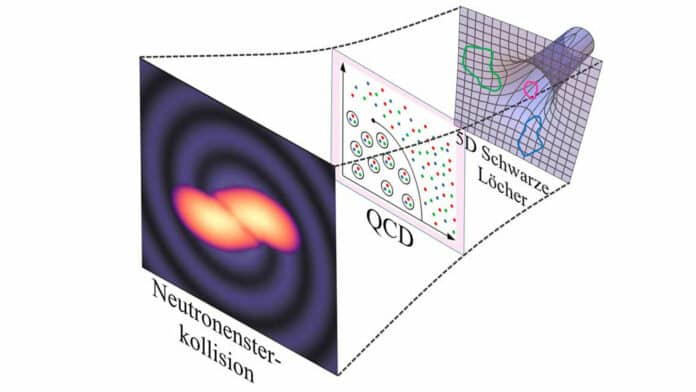Neutron stars are the densest objects in our universe, except for black holes. They are mainly made of neutrons.
We still need to understand the material created when two neutron stars collide fully. Scientists from the Asia Pacific Center for Theoretical Physics in Pohang and the Goethe University in Frankfurt have now created a novel model that sheds light on the behavior of matter in such extreme circumstances.
The first direct measurement of gravitational waves, the minute ripplings in spacetime caused by the collision of two neutron stars, occured in 2017 here on Earth. However, it is unknown exactly what makes up the hot and dense merging product produced.
It is still an open question, for instance, whether quarks, otherwise trapped in neutrons, can appear in free form after the collision.
Dr. Christian Ecker from the Institute for Theoretical Physics of Goethe University Frankfurt, Germany, and Dr. Matti Järvinen and Dr. Tuna Demircik from the Asia Pacific Center for Theoretical Physics in Pohang, South Korea, have now developed a new model that allows them to get one step closer to answering this question.
In this study, scientists extended models from nuclear physics, which are not applicable at high densities, with a method used in string theory to describe the transition to dense and hot quark matter.
Dr. Demircik and Dr. Järvinen said, “Our method uses a mathematical relationship found in string theory, namely the correspondence between five-dimensional black holes and strongly interacting matter, to describe the phase transition between dense nuclear and quark matter.”
Dr. Ecker said, “We have already used the new model in computer simulations to calculate the gravitational-wave signal from these collisions and show that both hot and cold quark matter can be produced.”
Scientists are further planning to compare their simulations with future gravitational waves measured from space to gain further insights into quark matter in neutron star collisions.
Journal Reference:
- Tuna Demircik, Christian Ecker, and Matti Järvinen et al. Dense and Hot QCD at Strong Coupling. PHYSICAL REVIEW X. DOI: 10.1103/PhysRevX.12.041012
